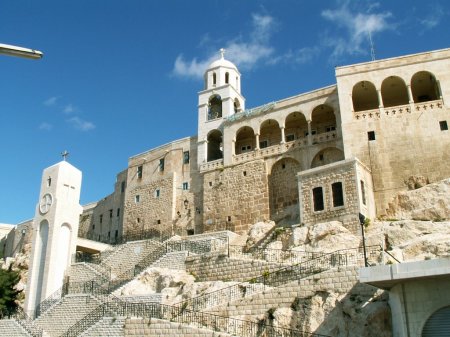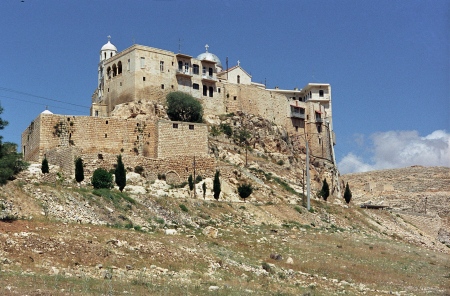Carmen Jokhadar As-Safir
The damage resulting from fighting that one will see on the way leading to the Saidnaya monastery is insignificant — some crumbled rocks and burnt grass. However, once one steps inside the monastery, the hair-raising and shocking magnitude of the damage, whether it is the broken glass or the multiple blows inflicted to the roof, becomes visible. The destruction has been caused by missiles and shells which gunmen used as they tried to conquer the monastery and bring down the bronze sculpture of Christ. “A single step can put your life at risk, sniping is still underway,” says a soldier. In the corner, two people are talking about last night’s developments. Not one quiet night goes by at the monastery.
Historians tell us that the Cherubim Monastery (cherubim is Arabic for “angels”) dates back to the third century, given the caves inside the mountain. Some of these caves, to which Christians once escaped from the persecution of pagans, can be seen as one heads to the top of the monastery. In 529, the initial edifices for worship were built, and with time, they turned into ruins. The monastery was first mentioned by Arab writer Chihab al-Din al-Umari in the 14th century. He stated: “This monastery was built by the Byzantines with limestone,” and he described its architecture.
In 1737, British prelate Richard Pocock found one monk at the monastery, and wrote that “the Cherubim Monastery is inhabited and accommodates one monk and one church that is in good condition and adequate for the celebration of prayers.” In 1982, under Patriarch Ignatius IV, the monastery was rebuilt on the highest point of the Qalamoun Mountains, with its original design and architecture preserved.
Reaching the Cherubim Monastery from Damascus requires around 90 minutes for the 8 kilometer distance because of the numerous checkpoints and thorough searches, particularly in areas that were previously under the control of opposition gunmen, such as al-Tal. From the checkpoint in Saidnaya (near the Paradise Restaurant) to the Cherubim Monastery, one cannot stop for even a moment on the road. To avoid snipers, the car speeds toward the monastery in the middle of the vast mountains, through the populated area, until reaching the towering monastery at an altitude of 2,130 meters. From the monastery, one can see the majority of the Qalamoun areas and the joint slopes with Lebanon.
It is not the first time that the monastery has been attacked. A year ago, mortar shells fell on it and there were attempts to infiltrate it. The latest attack is the fourth.
In addition to its religious importance, the monastery has great strategic and military value that helps in controlling the surrounding plain, cutting the supply of arms and besieging the towns of Saidnaya, Marouna and Maarra. Conquering the monastery would allow to control the road leading from Yabrood to Rankous and al-Tal, and give the islamic militants a key base in the Qalamoun region.
A military source in Saidnaya confirmed that “the Syrian army and national defense forces are fighting desperately because the war is against takfiri groups and they want to defend their homeland, the territory, and their dignity.” He added, “It is either the monastery or death. The icons there serve as an honor for us. Six soldiers were killed in the latest attack.” With a sad tone, he explained, “Imagine that a stranger is slaughtering me on my own territory,” and he pointed out that it was possible to eliminate many gunmen, yet the most dangerous battle was still the one against takfiri groups that had swept Syria.
“The battle at the Cherubim Monastery is a direct message and attempt to achieve a field gain to put pressure on the Syrian official delegation during the negotiations in Geneva.”
The commander of the Cherubim Monastery operations told As-Safir, “The attack was based on three groups: an assault force (itself divided into two groups — the first tasked with turning from the southwest and attacking gunmen, and second with cutting off supply and aid coming from Rankous), a cover force and a backup force.”
“The battle began at 3:30 a.m. with a surprise attack through fog carried out by terrorists against the surrounding military points. Three soldiers were killed. The fighting continued until 5:15 a.m. and gunmen were able to reach the boundary walls of the monastery. There they were buried.”
He pointed out that, at 7:45 a.m., some militants tried to escape and the last one of them was killed at 8:35 a.m. The monastery was subsequently under massive shellfire until 10 a.m. It then turned into intermittent shelling until 11 a.m., as Syrian forces started firing back. A field commander confirmed that, since the last attack, the monastery had been struck by mortar shells and subjected to infiltration attempts on a daily basis. He stated that “the forces defending the town launch sporadic strikes because the presence of civilians in the region prevents the possibility of a comprehensive qualitative military operation. As it is the case in Adra, the insurgents are using children and women as human shields.”
A participant in the clashes at the Cherubim Monastery indicated that “militants carried perfume bottles, a toothpick and women’s underwear. In terms of military equipment, they had communication devices, grenades and machine guns, and each of them carried a knife. They also had raw meat that they would use in case of serious wounds (since some believe placing a piece of meat on a wound quickens the healing process).” The participant indicated that the militants burned the bodies of their own dead in the mountains to prevent identification and so that they would not be forced to carry the corpses. Transportation is difficult because Syrian forces have many observation points in the region.
According to one participant in the fierce battles, militants were filming the operation, and a satellite channel even heralded the breaking into the Cherubim Monastery and the fall of Saidnaya.
Meanwhile, an officer in Saidnaya, having moved between several hotspots in Syria, said that “militants in Syria are divided into four groups: militants on the border who benefit from smuggling operations, jihadist militants, criminals wanted by the judiciary, and young men forced by militants to join their ranks under threat.”
He asserted that the situation was improving and the protests staged recently in a number of Syrian cities against the militants were the biggest proof of that. Even if the participants in the protest marches were not necessarily affiliated with the Assad regime, they were rejecting the presence and practices of foreigners on their own land. Those foreigners surely had shown creativity in committing murder, rape and shameful practices against humanity, morality and religion. “Takfirism undermines pacifism — the prevailing ideology. It also violates religions,” he added. “We are fighting for our honor, our true religions, our civilization, our future and the future of our children.”
A source monitoring the battles in Saidnaya confirmed: “I have counted 63 corpses until today of gunmen from Syria, France, Kuwait, Saudi Arabia, and Afghanistan,” pointing out that negotiations are underway about the delivery of 18 of them.
A military source in Saidnaya reported, that the people of the region as well as the fighters from the National Defense Forces and the Syrian army expect the militants to launch a big offensive for four reasons: the strategic and military importance of the site, its religious symbolism, their desire to avenge their defeat in the recent battles and, most important, the warning of financial supporters to cut off aid if “victory or at least a breakthrough” was not achieved.
Though the militants are constantly attempting to break into the Cherubim Monastery, which houses the second-largest statue of Jesus Christ in the world and the largest in the region (it was erected in 2013), they are defeated by the guards of the monastery, which come from different religions (as it is documented by their names). The statue of Christ on the mountain, holding a sign that reads “I come to save the world,” is saving the Qalamoun region from the foreign warriors.


Keine Kommentare:
Kommentar veröffentlichen